KATE GOULD:
JOURNEY THROUGH THE GRADES
WALDORF STYLE
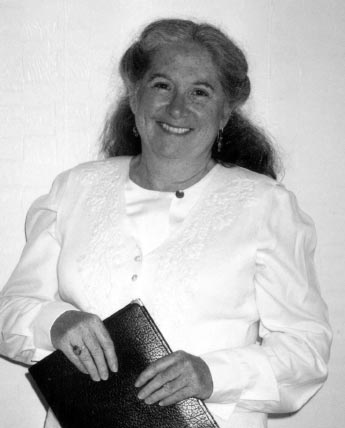
All photos
provided
I began teaching using Waldorf methods in 1984. Starting
with first grade, I continued teaching the same group of children
until they graduated from eighth grade. That year a teacher
left so I picked up her class in third grade and remained
with them until their graduation, six years later. Then in
1998 I took a first grade once again. This was my third class.
By the end of that year I had been teaching at the Waldorf
School of Mendocino County for fifteen years. The following
year I made a difficult decision to accept a position at the
newly formed River Oak Charter School, a Waldorf methods school,
which opened in the fall of 1999 in Ukiah.
River Oak is a public school using Waldorf methods. It was
exciting to consider using Waldorf methods that had worked
so well in the past in a public school setting. There was
some concern that the Waldorf philosophy would be compromised
by public school expectations and standards. My teaching style
and curriculum content have not been greatly altered in the
charter school, although there are necessarily accommodations
to meet state requirements and standards.
DEVELOPING MEMORY
Children today are awake earlier. They seem to be very self-possessed
and self-confident in ways I haven’t seen before. Their
vocabulary is much more expanded and they understand concepts
that I would attribute to older children. I told a story to
my second grade class this year and, as we were recalling
the story on the following day, one student began to explain
the meaning of the story. The depth of her interpretation
was amazing.
It is understood that as part of the daily lesson, a Waldorf
educator will tell a story. The following day the children
recall the content of the story in some way. In this way,
imagination is developed and the memory is trained. Many of
the children in my current class are able to retell the story
from the day before, or even weeks before, in graphic detail.
They take the story into themselves in very personal ways.
Children who initially do not remember details benefit from
the retelling by other students and eventually their own memories
are strengthened. Each lesson is unique.
After taking two classes through the grades, I had a full
understanding of the potential of teaching a Waldorf curriculum
and decided to go through the entire process one more time.
Of course, I’m still learning and finding stories and
concepts that deepen my inner growth. I am delighted by the
children’s responses to this education. I love the creative
act of putting a lesson together. A Waldorf lesson works with
the thinking, the feeling and the activity life of the child.
Each lesson involves a creative act of forming the lesson
and combining it with activities and artistic contributions.
This is both demanding and inspiring for me. I love my relationship
with the children. I am excited about each new developmental
phase.
Each lesson is fresh. I don’t depend on what I did before.
Each class of students asks for something different. I have
to understand my class—who the children are and what
their particular needs are. Those unique relationships with
the children continue as the teacher travels up the grades
with the class. Each year the teacher using the Waldorf model
will prepare for a different grade. She must build a new curriculum
each year, finding the stories, the poems, the movement exercises,
new songs to sing and play on the flutes. The artistic and
academic skills are integrated. This process is positively
energizing.
BALANCED EDUCATION
Some parents bring their children to the school because they
hear that the Waldorf method is good although they do not
know much about it. What wins the parents’ confidence
most is that they see happy children at the end of the day.
Maybe one parent wants to bring the child to the school but
the other is reluctant. I remember a dad who brought his child
to school and he seemed a bit grumpy. Weeks later he mentioned
to the teacher that he didn’t understand why, but his
child liked coming to school. By the end of the year, this
father was playing with the children on the playground and
joyfully participating in the life of the school. Participation
and understanding comes in stages for the parents and for
the children as well. It is not uncommon that a child does
not come to the school of his or her own free will. When parents
choose the school and their child has been dragged away from
friends and the familiar routines, the child may enter the
classroom the first day reluctantly. Right away we are singing
and reciting verses; we’re moving and drawing pictures.
We are writing our own sentences and making a main lesson
book, which is one of a kind. In the afternoon, we are playing
active games. We are learning how to play a flute, a violin,
or playing in the orchestra. We have handwork classes. A boy
in second grade spontaneously said one day, “I like this
school. We get to knit. I didn’t get to knit in my other
school.” He had successfully made the change into his
new school setting.
It’s wonderful when children don’t carry rigid gender
stereotypes. Holding the needles and putting them in the right
place, looping the yarn around and pulling it through and
creating the knot—all this takes a steady hand and concentration.
Then there is counting stitches and making patterns, increasing
and decreasing. You can see how this may help with reading
and arithmetic.
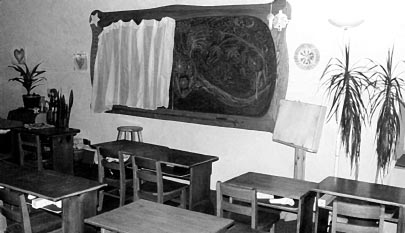 |
|
Typical
Waldorf classroom with blackboard covering the week’s
main lesson drawing.
|
HANDWORK
In first and second grades, the children learn to knit. They
make flute cases and animals. By third grade they will learn
to crochet, and in fourth grade the children will create designs
for a cross-stitch project. They make a grid drawing of a
symmetrical pattern and then match the drawing with the cross-stitch.
Think about the effort and activity in that! Imagine the confidence
that the children develop when they see what they can do with
their own hands. The results are beautiful.
BEHAVIOR
Since a Waldorf teacher stays with the class for many years,
I am often asked what would happen if I didn’t get along
with a child. I have not found this to be a problem. I have
disliked what a student does sometimes but that is not the
same thing as disliking the child. It is possible to see through
the behavior to something on the other side. The question
is, why is that child behaving that way? It may be as simple
as they didn’t have breakfast in the morning or didn’t
have enough sleep. It may be something deeper, a physical,
emotional, or constitutional reason. I remember observing
a class some years ago with several children who were repeatedly
falling off their chairs. It never failed to make the other
students laugh. These children had found a clever way of drawing
attention away from their own fear of not being able to do
what the rest of the class was able to do.
If a child constantly interrupts or talks when you are giving
directions, it’s irritating, but you don’t dislike
the child because of it. Two minutes later that same child
will be doing something else that is endearing. It is necessary
to be thinking, “How am I going to work with this behavior
so that this child learns how to be in the class and to function
with the others in a way that benefits everyone.” Or
“Why is that child irritating me right now? Is it because
he is defying me?” From another point of view, there
may be something going on in the class that is irritating
the child!
THE NINE-YEAR CHANGE
Between eight and ten years old, instead of accepting everything
that an adult has to say as the last word, children start
to question authority. If you don’t know that is coming,
it can be very disconcerting. If you do know it’s coming,
you will think, “Oh, my gosh, that child is waking up
to the world. He or she is asking questions.”
When I was participating in the Big Brother/Big Sister Program,
I was matched with a child from Mayan ancestry. Everybody
in her family had wide faces and wide noses. I have a small
face and freckled nose. This girl came into my life just as
she was going through this nine-year-old change. We were spending
time together one day, and I noticed she was staring at me.
I asked, “What is so interesting?” and she said,
“Your nose is so small!” It wasn’t a compliment.
From her perspective that was not the way noses should be.
If you know that the observation is a sign of an awakening
awareness, it is possible to be grateful that the child is
noticing differences. No need to take offense.
In the classroom, if a child is lying, stealing, or doing
some other anti-social behavior, it is possible to bring a
pedagogical story to the whole class. Sometimes it is not
necessary to single the child out. In the pedagogical story
you might change the gender of the protagonist. Then tell
the story in such a way that the situation is resolved in
a positive way. Since it relates to that child’s problem,
the child will receive the message on a very deep level. The
story works on the child’s imagination to build up social
forces.
Sometime between eight and ten years old (depending on the
child’s personal unfolding) children wake up to the world
and begin noticing things they didn’t see before. They
may have the painful feeling of becoming separate. The child
may no longer feel that harmonious oneness with the world.
A child may feel she doesn’t belong to her parents and
may ask them if they adopted her. This is the time when the
children stop believing in Santa Claus, the Easter Bunny,
gnomes and fairies—and when the world of the creative
and fantastic is replaced by a more mundane world with “faults.”
This is the beginning of the emerging individuality. Bringing
stories that meet the child’s developmental needs is
very helpful in getting through this stage. In the early days,
what did humans have to learn to do to make their way in the
world? The Waldorf curriculum provides the children with experiences
in farming, cooking, weaving, carpentry, and other practical
activities.
In the third grade, lessons in house building are introduced.
These studies involve the children in math and measurement
skills. Projects include planning and building improvements
for the school and making models of different types of houses
around the world.
Clothing studies introduce fibers and clothes from a variety
of cultures. Practical activities include felting, spinning,
dying and weaving. What do we have to do to provide food for
ourselves? We take up the subject in a farming/food block
of study. The children may go out to a farm and plant and
irrigate and harvest. We also prepare foods in the classroom.
As the children mature there come new expectations and the
education changes to meet the child’s developmental stage
and their inner personal needs. The stories told in class
are chosen to nurture them as they go through each growth
crisis so they can make transitions without fear. They build
up self-confidence. They can say to themself, “Look I
can take care of myself. I can build a bench. I can build
a playhouse.” It’s amazing to watch the children
go from feeling the loss of that perfect world to feeling
confident and capable.
Learning is very intellectual unless you also develop the
feeling life and the will to actually do things out in the
world. Everyday the rhythm of the lesson engages all three—the
thinking, feeling and willing.
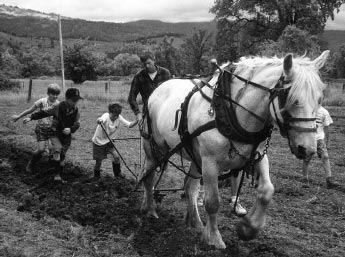 |
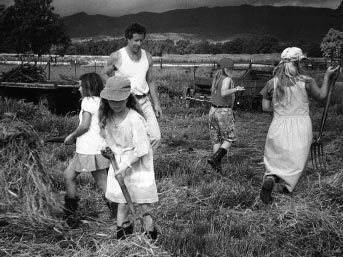 |
|
“The
Waldorf curriculum provides the children with experiences
in farming, cooking, weaving and carpentry, and other
practical activities.” Children farming at Decatur
Live Power Community Farm, Covelo, California.
|
THE RHYTHM OF LEARNING: GETTING ITO THE DAY
When the children come to school in the morning, they will
have some time to play in the schoolyard together before they
enter the classroom. This gives them time to greet their friends,
socialize and run around a little bit. A brass bell rings
to signal the beginning of the school day. As the children
come to the door of the classroom, the teacher shakes their
hand and gives each one a personal greeting. “Good morning,
Rebecca.” That child pauses in front of the teacher and
shakes hands. In that moment of personal exchange, the teacher
can assess the child’s mood and their health. She can
notice if they have rosy cheeks or if they look pale. Do they
have a running nose; is their hand clammy? You can tell a
lot about a child in that moment. This exchange is brief but
it’s important.
In my class, the children come in and put on indoor shoes,
and move to their desks. The teacher then greets the class
as a whole and the morning has begun. I like to have a few
minutes of personal sharing at the beginning of the day. The
children bring news from the outside.
“I’ve got a new kitten,” “I’m going
fishing with my Dad.” Children bring in treasures they
have found on trips such as shells, rocks, pine cones. These
things stimulate conversation about the world. Then the morning
lesson begins with opening verses recited chorally and movement
activities.
I like to break up the day with verses and songs so that I
am not giving commands all day long. I have a song to transition
the children from sitting to standing. We do movements to
warm up, to help the children get into their bodies and to
work socially together. We say verses that inspire reverence
for learning and seasonal songs and verses to connect them
with the time of year.
Rhythmic movements may accompany specific learning: repetition
of a times table goes along with a song or verse and physical
movements so that the learning gets right into the limbs.
Stepping the times tables is so much fun that the children
don’t even know that they are learning. We do different
movement patterns for each times table: for the twos they
have sticks that they rhythmically click and pass. Some children
pick up the time’s tables right away; those who are slower
are carried by the group, and eventually they get it. One
child who absolutely could not memorize times tables was able
to sing the Frère Jacques tune repeating 3, 6, 9, 12—3,
6, 9, 12. He knew the tune and by adding these words, the
learning became easy and enjoyable.
MAIN LESSON
Main lesson takes place during a two-hour block of time in
the morning. We recall the main lesson story from the day
before and then tell the new part of the story or an entirely
new one. I think it is important to emphasize that stories
are told and not read. This makes them much more engaging
and lively. In the telling you can make eye contact with the
children and add parts that engage all the different children
and their temperaments. If you see a phlegmatic child going
off into a fantasy, you can bring her back to Earth by talking
a little bit about food. You could add a description of a
great feast talking about the smells and tastes of the food.
Speaking of temperaments is just a way of identifying a predominance
of certain characteristics that a child may embody. The phlegmatic
child is dreamy and possibly exhibits a lack of initiative
initially. A choleric child is full of energy, initiative
and self-confidence, but may be slightly aggressive. Sanguine
children are very social and cheerful and also a bit distractible.
They are the ones who want to do something one minute and
two seconds later they are anxious to do something else. And,
then, melancholic children are extremely serious or moody.
If a storyteller addresses all these tendencies, she will
really capture the children’s attention and interest.
The phlegmatic becomes grounded when you talk about food,
the sanguine likes the movement and change in the story and
the choleric child likes conflict or challenges. For the melancholic
child, you appeal to the feeling life. A good story will contain
all these elements.
Using the Waldorf model, the main lesson is taught in a three-day
rhythm. On the first day is the telling of the story by the
teacher. The following day, the children recall and retell
the story. This can be a verbal retelling or in the form of
free rendering—as a drawing or construction—which
gives the children an opportunity for creative expression.
New information from the teacher is also added. On the third
day, the child creates something, either in writing or drawing
in the main lesson book. So, you have new learning on the
first day but you don’t practice it on the day it is
presented. The child has an opportunity to sleep on it. The
second day there will be a practice activity. On the third
day, something concrete goes, in a permanent form, into the
main lesson book, the child’s self-made textbook. The
children get used to that rhythm. By engaging the mind, feeling
and action, the learning deepens and becomes part of the whole
child.
The students are constantly processing concepts. This is different
than just presenting information. Information is data, little
bites of things, and not the whole. By taking two hours each
day for the main lesson, the child has the necessary time
to integrate the lesson. The art of teaching is the ability
to present that rhythm for learning in an effective way.
The main lesson is taught at the beginning of the day when
the children are most alert. Then there is time for a snack
and a recess/free play in the yard. In the middle of the day
they come back for two more periods that cover language arts,
reading, art and music. Then comes lunch and recess. The afternoon
classes include games, handcrafts and other physical learning
opportunities.
The main lesson teachers also teach specialty classes. After
main lesson, they may leave their class in the hands of another
specialty teacher and travel to another class to teach subjects
they have developed. I often teach drawing, painting, modeling
and handwork.
|
|
|
Ms.
Gould’s First-First Grade Class, 1984, Montgomery
Woods
|
THROUGH THE GRADES
In kindergarten, the emphasis is on learning by imitation.
They move in circle activities, do puppet plays, listen to
stories and act out fairy tales. They play. The kindergarten
is filled with simple objects that stimulate imitation and
imaginative play. Silks and fabrics are used for costumes.
After listening to a story about kings and queens, or a princess
and prince, the children can put on silk capes and become
those characters. They can use nice pieces of wood for building.
The dolls are simple and not too formed. That way the children
can bring their imaginations to those dolls and to how to
play with them.
Each day kindergarten involves the children in some highlighted
activity such as painting or modeling. The children learn
to sew and to cook soup and bake bread. They work together
to set the table and make snacks. In these activities, they
are building social and language skills to prepare them for
first grade. They aren’t using worksheets.
In first grade, the children begin to learn to read first
by writing. They learn their letters; the letters becomes
words; the words become sentences. They read their own sentences,
their own books. They build confidence for reading by reading
what is familiar to them. They learn word families and simple
phonics. They may act out a play and then read the text.
The children learn their numbers and all four computational
skills in first grade—adding, subtracting, multiplying
and dividing. That is a little bit different from most public
schools where they learn division later. Math is taught in
a concrete manner, showing the connections between these processes.
Each child might get a little bag filled with jewels or a
basket of acorns. They add and subtract them, making groups
and piles.
Each teacher uses his or her imagination to give the math
processes life. I invented math helpers: Diana Divide is a
large girl who wears a bright red dress because she is so
warm and giving. She wants everything to be fair and equal
and she divides her whole array of jewels into equal parts.
Timothy Times is her best friend. He is thin and lively and
wears the color yellow. He is wearing yellow because he is
expansive. He doesn’t want to add 1, 2, 3, 4. He wants
to say: 2, 4, 6, 8. He views them in terms of division or
multiplication.
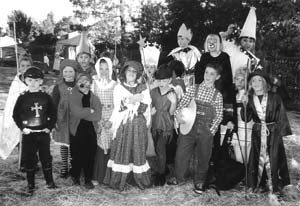 |
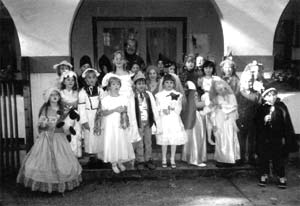 |
|
|
|
Two
Halloween Photos, Second grade, River Oak School (top),
First grade, private Waldorf school (bottom)
|
Children act out these parts with costumes. Peter Plus is
rotund and dresses in a green tunic. He loves to add and add
and wants more and more and more. He is a best friend with
Minny Minus who is a little bit melancholic. She has a big
hole in her apron pocket and wherever she goes she loses her
jewels. So Minny Minus always ends up with less than what
she started with. Peter Plus is happy because he is picking
them up. As the teacher tells these stories, the children
remember the images and they don’t forget the pictures.
I have seen children go into a panic when asked to solve word
problems. If I say: “What is happening? Which helper
do you need to call on?” They say, “Oh Minny Minus.”
It comes to them like that. Solving story problems has been
easy because the children have these characters to help them.
In first grade, the teacher or a student puts on a costume—a
tunic with the arithmetic signs stitched on it and a matching
gnome hat. Then the arithmetic problem is acted out in a concrete,
visual and very imaginative way. They acquire a wonderful
feeling for numbers and carry that into the next grade. I
started off my first math lessons in second grade by bringing
Diana Divide, Timothy Times, Peter Plus and Minny Minus back
but, by the end of the year, all I needed to do was mention
them once in a while.
There are particular types of stories in each grade from which
a lesson is developed. For example, folk tales and fairy tales
in first, fables and hero stories in second. I like to make
this a multi- cultural experience for the children.
I told the story of Jerome, a monk who hand copied ancient
Hebrew and Sumerian texts into Greek and Latin. In that way,
he preserved the ancient cultures. I compared what Jerome
was doing with their own writing efforts. They could recognize
the value of each drawing and each letter that they put into
their own main lesson books.
These stories should deepen our understanding of life values.
The hero overcomes some powerful obstacle in order to do good
in the world. These higher values are healing and inspiring
to the children.
We also study creation myths in third grade: Hebrew, Native
American, African, Chinese, Japanese, Mayan. I choose stories
for the children who are presently in the class.
Third graders learn measurement, both liquid and linear. Building
on past skills, the new learning is advanced by tying the
processes to the practical activities: housing, clothing and
food around the world.
In fourth grade, the children study fractions. They enjoy
bringing in sheet cakes to divide—into fractions. They
will find many ways to divide the cake; they will experience
the whole cake and will eat parts of the cake. No part of
the cake is ever wasted. We study myths in fourth grade. The
ten-year-old is ready for creation myths and trickster stories
from all cultures—Norse, African, Chinese, Japanese and
Native American, for example. By this time, reading skills
are strong and children are reading for information. There
will be a block study of the unique characteristics of animals,
the relationship between animals and human beings. The children
will choose an animal to study.
Fifth grade is one of my favorite years because in this grade
the children study ancient cultures of India, Persia, Macedonia,
Egypt and Greece—each one bringing a different kind of
wisdom.
In sixth grade, we explore Roman history and Roman life and
how this culture relates to us today. We also study the invasions
of the barbarians, the fall of the Roman Empire and the beginning
of the Middle Ages. Pre-algebra and the physical sciences
include experiments with light and sound.
Sciences have been studied in each grade using appropriate
activities for the grade level. In first grade we might tell
an imaginative story about the water cycle and then the subject
will reappear in the study of meteorology. In the upper grades
we set up experiments for the class to observe and record
observations. From sixth through eighth grade, physics, physiology,
meteorology, geology, botany and chemistry are discovered.
The Middle Ages are completed in seventh grade and then we
introduce the Renaissance—a time rich in possibilities.
In seventh and eighth grades we study the biographies of scientists,
artists, writers, and other great people. Eighth grade examines
the Industrial Revolution and continues history studies through
modern times. Lessons include a thorough picture of American
government.
Lessons in geography begin in fourth grade when we take local
field trips and study California history. We start with where
we live and then expand out further and further—from
California to the ancient world and from there to the modern
world, which is born in the Renaissance. In eighth grade,
we are carried into the present time with discussions of current
events.
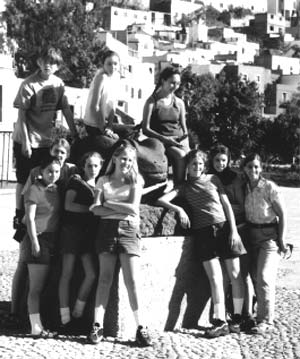 |
|
Eighth
grade calss in Mexico, 1998
|
In eighth grade, we also listen to famous speeches. The students
learn to write their own. On graduation day, each child gives
a speech to attentive parents and friends who have come to
celebrate this transition into high school. These speeches
include tearful memories of joyful events, acknowledgments
of parents and classmates, expressions of gratitude to their
teachers and humorous observances. It has been a long meaningful
journey between first and eighth grade.
This brief curriculum sketch is incomplete, of course, but
can give you an idea of the way a Waldorf teacher advances
his or her class through the grades.
BEYOND WALDORF
The students in my first class have all had some college experience
and most are getting degrees. My second group of children
is still in high school and is doing excellent work. I have
been told that they are getting 3.5 or better grades. Their
parents tell me that they still love to learn and their high
school teachers enjoy having them in their classes. Some are
active in sports. Several are musicians. One student was in
three Ukiah Players productions last year. Several of my former
students traveled abroad this year. They sent me post cards
telling me about seeing places that they had studied in seventh
grade. They expressed their enthusiasm for experiencing the
world that they had learned about in class.
I attended the wedding of one of the children in my first
class this summer. At least two thirds of my first class was
there. As I spoke with former students, I learned that many
of them are taking double majors in college— blending
the arts and sciences, such as music and biology. Isn’t
that interesting? Intuitively they seem to know the importance
of this kind of balance in their education.
The newly wedded couple has a ginger farm in Hawaii. Their
parents created a wedding registry at a local lumber store
where friends could purchase building materials for their
new home. I purchased cement piers. I had contributed to this
person’s educational foundation, now I would provide
the foundation for her first home. I loved that concept!
PARENT INVOLVEMENT
A Waldorf school—whether a method school or a private
school—involves the parents in a child’s education.
The parent nights, festivals and plays at the school are community-building
events. Parents show up to work on the playground and build
play structures. Not all parents do the same amount of work,
but they do what they can. This year, I had an impressive
percentage of parents help in our class or the whole school.
They participated in reading groups, knitting projects, supporting
standardized tests by bringing nutritious snacks. At the end
of this school year, the parents painted the classroom and
washed down the desks. They will assist in setting up the
class for the new school year. They served on committees to
help design curriculum and evaluation processes. Parents created
a playground out of a parking lot! This is to mention only
a small part of the participation of parents in the school.
It is very gratifying to see parents so involved in their
child’s education.
 |
|
“Lynn
Meadows made an announcement that everyone who had been
in my first class
should come to the bandstand for pictures.”
Caroline Frey’s Wedding, June 2000, Photo courtesy
of Katrina Frey, Redwood Valley
|
STANDARDIZED TESTING
Since so much of standardized test taking has to do with reading
skills, test scores from Waldorf methods charter schools were
expected to be somewhat lower than average in the lower grades
because we don’t push early reading. I have excellent
above grade level readers in my second grade class and children
who are just learning. But the scores on the standardized
test were surprisingly high. It has been shown in the Waldorf
method schools that have been around for a few years, that
test scores dramatically rise in the upper grades and stay
high. It is important to look at the big picture to get a
feel for what is happening. I question whether or not standardized
tests are able to test a child’s true intelligence. How
can they? Children exhibit intelligence in different ways.
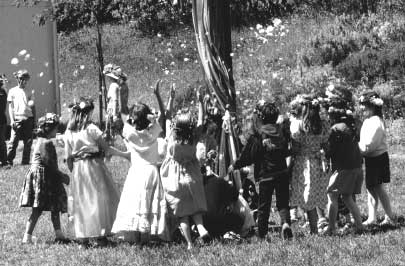 |
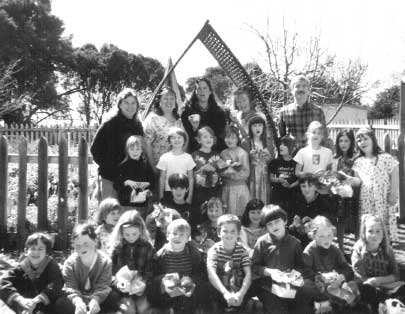 |
|
First
grade tossing rose petals May Day, 1999 (top),
Firstt grade class, end of year, 1999 (bottom).
|
COMPUTERS IN
THE CLASSROOM
Our school teaches thinking skills and builds imagination
without the technical backup of computers in the classroom.
The teacher is still the authority, guiding the children through
activities that help them build confidence. Eventually, technology
is a useful tool, but I personally don’t feel that it
is necessary until the children have mastered basic skills
on their own. I like to see students reading books and learning
how to talk to people to get information in the early grades.
The young children before six and seven years old are learning
by imitating other human beings and the seven to fourteen-year-olds
are building up their feeling life. After that, thinking and
intellectual development are in the forefront. All of these
modes of learning are happening together but the emphasis
changes at different stages of life. We want to teach what
is appropriate to each developmental age of the child. I’m
not against technology. I use a computer at home and acknowledge
its value, yet I am opposed to depending on computers in the
lower grades.
THE SPIRIT OF TEACHING
Several new charter elementary schools have opened in recent
years. A charter high school will be opening in the Ukiah
area this fall and a Waldorf methods high school is also in
the planning stages. If we want to support democratic principles,
shouldn’t we support freedom of choice in schools? I
would like to see schools reflect the values in the home.
If the values of school and home are not the same, it is confusing
to the children. Yet, in learning to meet the needs of students
today, it is important to remember that no one approach is
perfect. Learning how to teach, how to create a living education
that meets the needs of children today is a process.
Sometimes I have felt harshly judged about the way I taught
something in class when in my heart I felt I was meeting the
children’s needs. I believe a good teacher doesn’t
follow a system dogmatically. Rudolf Steiner, the founder
of Waldorf education, spoke of indications for teaching children
certain concepts. He encouraged teachers to observe and know
their children. There is always a danger of following a method
slavishly without truly understanding where you are going
with it. I have come to recognize that there is more than
one right way to approach any subject. The key to good teaching
is enthusiasm. The challenge is to set a worthy example.
|
|
|
Michaelmas
Celebration; St. Michael & Angels on roof
Waldorf School of Mendocino County
|